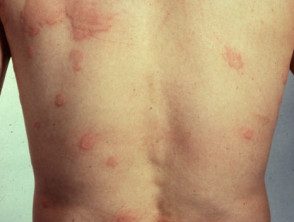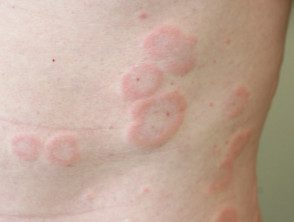What is it urticaria?
Urticaria is a common skin reaction characterized by cure, which are caused by the launch of histamine and other vasoactive substances from mast cells. Edema is on the surface dermis in urticaria, while the swelling is deeper in the skin angioedema [1].
Drug-induced urticaria

Urticaria on the back of a young man.

Spontaneous urticaria

Urticaria.
See more hives images.
What is drug-induced urticaria?
Drug-induced urticaria is the term used when urticaria is caused by a drug, most often penicillin, a steroidal antigen.inflammatory agent (NSAID) or sulfamethoxasole in combination with trimethoprim (see Sulfa and skin medicinal products) [1]. The drug can be ingested or applied to the skin surface (contact urticaria).
The clinical characteristics and treatment of drug-induced urticaria are identical to those of non-drug-related urticaria. [two].
Drugs are capable of inducing three subtypes of urticaria:
- Acute urticaria
- Chronic urticaria
Contact urticaria [1].
Drug-induced urticaria is sometimes called drug urticaria.
Who gets drug-induced hives?
Urticaria is one of the most common drug-induced skin. rashes, only surpassed by morbilliform eruption [1,2]. In external consultation dermatology Clinically, drug-induced urticaria is estimated to affect 9% in patients with urticaria [1,3]. Gender and racial predominance They are not clear.
- Acute drug-induced urticaria is the most frequently observed subtype in adults and children. [one].
- The estimated prevalence of chronic drug-induced urticaria is between 0.5 and 3%. [one].
- Chronic drug-induced urticaria is rare in children. [one].
What causes drug-induced urticaria?
Drug-induced urticaria can be mediated by immune or non-immune mechanisms related to administration or contact with a drug. [3].
The immune mechanisms are allergic reactions mediated by the immune system (see Allergies explained) and includes urticaria due to type I hypersensitivity (IgE dependent) and type III hypersensitivity (mediated by immune complexes).
Not-immune The mechanisms are pseudo-allergic reactions and do not depend on the immune system. Nonimmunological mechanisms include direct release of mast cells mediators, an effect on the cell membrane and the activation of complement system without immunoglobulin [1–3].
Drugs known to cause hives.
Listed below are medications known to cause hives. Medications marked with an asterisk (*) are strongly associated with hives.
- Angiotensin conversion enzyme inhibitors (ACEI) *
Antibiotics: penicillins *, cephalosporins *, macrolides (erythromycin), aminoglycosides, tetracyclines *, sulfonamides, vancomycin, fluoroquinolones
Anticoagulants: low molecular heparin weight, protamine sulfate
- Anticonvulsants
Oral antifungal agents: fluconazole, ketoconazole, griseofulvin *
- Antineoplastic agents: alkylating agents, taxanes, methotrexate
- Betadine (povidone-iodine)
- Bisphosphonates
- Dextrans
- Dextromethorphan
- Enzymes: trypsin, streptokinase, chymopapaine
- Hydantoins
- Hydralazine
- Mannitol
- Muscle relaxants: atracurium, vecuronium, succinylcholine, curare
- NSAID*: ibuprofen, naproxen, diclofenac
- Opioids: morphine *, codeine *, meperidine, fentanyl • Paracetamol
- Polypeptide hormones: insulin, corticotropin, vasopressin
- Progesterone
- Quinidine
- Radiographic contrast agents *
Salicylates * including aspirin
- Sorbitol complexes
- Corticosteroids
- Thrombolytics: alteplase, urokinase
- Vaccines
What are the clinical characteristics of drug-induced urticaria?
The clinical features of drug-induced urticaria are identical to urticaria that is unrelated to drugs. The severity of the reaction can be variable.
Hives can affect any part of the body and tends to be widely distributed. The trunk is more frequently affected, although this is not specific to drug-induced urticaria. Palms, soles, and the scalp can also be affected. [one].
Injuries are typically severe pruritus and can induce a burning sensation. Hives are classified according to their duration. [4].
- Acute urticaria lasts less than six weeks and often goes away within hours or days.
- Chronic urticaria lasts for more than six weeks, with daily or episodic scarring.
In acute drug-induced urticaria, scars appear within a few hours to a few days after administration of the drug. They usually disappear within a few days of the drug. cessation.
In chronic drug-induced urticaria, a prolonged recurrent-remitting course is often observed, and the urticaria resolves from time to time.
In contact urticaria, the lesions are located to the application site, although sometimes the urticarial injuries can become generalized to the rest of the body Contact urticaria develops from minutes to hours after the application of a current agent and resolves within a couple of hours of elimination of the cause [1].
What are the complications of drug-induced urticaria?
Drug-induced urticaria is often more severe and severe than spontaneous urticaria, resulting in hypotension, dyspnea and anaphylaxis [2].
Persistent urticaria can have a substantial impact on quality of life. [1,4].
How is drug-induced urticaria diagnosed?
The diagnosis of drug-induced urticaria requires a complete medical history. [4]. If necessary, the diagnosis can be confirmed by puncture tests, immunoglobulin E tests, and oral challenge tests. Other investigations may include hematology, tryptase, complement (C3 / C4, C3d), White blood cell release of urinary histamine and tryptase. These tests are not always reliable and often a decision must be made clinically [4].
Which is the differential diagnosis for drug induced urticaria?
Drug-induced urticaria can be confused with many conditions, including:
- Other forms of spontaneous urticaria
- Inducible urticaria
- Serum disease and serum reaction similar to the disease
- Urticaria vasculitis
- Urticaria-like lesions
- Erythema multiform
- Morbilliform drug eruption
- Maculopapular cutaneous mastocytosis
- Autoinflammatory syndromes
Note that angioedema can arise up to years after starting acetylcholinesterase inhibitors (RCTs) [5]. This is not accompanied by urticarial scarring.
How is drug-induced urticaria treated?
General measures
the causal drug it should stop when possible. If due to type 1 (IgE mediated) allergy, urticaria disappears in 48 hours. See Allergies explained.
Non-essential medications should be avoided if they may be contributing to hives.
Cooling the affected area with a fan, cold flannel, ice pack, or soothing coolant moisturizer lotion can provide relief.
Pharmacotherapy
The main pharmacological treatment for acute urticaria is a second generation oral antihistamine, such as cetirizine, loratadine, fexofenadine, desloratadine, or levocetirizine. [one]. If the standard dose (eg, 10 mg for cetirizine) is not effective, the dose may be increased four-fold (eg, 40 mg of cetirizine daily). Continue treatment until urticaria is well controlled, and then gradually reduce the antihistamine dose. A second type of antihistamine does not provide any additional benefit.
Although systemic It is best to avoid treatment during pregnancy and lactation, there have been no reports of birth defects due to second generation antihistamines. If treatment is required in pregnancy, loratadine and cetirizine are currently preferred [4].
Conventional first-generation antihistamines like Promethazine or Chlorpheniramine are not recommended for urticaria.
- They are of short duration.
- They have sedative and anticholinergic side effects.
- They damage sleep, learning and performance.
- They cause drowsiness in infants if taken by the breastfeeding mother.
- They interact with alcohol and other medications.
- Lethal overdoses are reported.
Treatment of refractory urticaria
If non-sedating antihistamines alone are not effective, a 4- to 5-day cycle of prednisone or prednisolone (systemic corticosteroids) can be added in severe acute urticaria, particularly if angioedema is present. [one]. However, systemic corticosteroids do not accelerate resolution of symptoms. Steroids are best avoided for long-term therapy because of their adverse effects and the risk of rebound when discontinued.
Intramuscular epinephrine (epinephrine) is reserved for cases with life-threatening anaphylaxis or inflammation of the throat. [two].
What is the result of drug-induced urticaria?
Patients who have had a true drug-induced urticaria due to type 1 hypersensitivity will have another attack, possibly worse, if they are re-exposed. Patients should be advised to wear a medical alert bracelet and inform their healthcare providers of their adverse reaction to the causative drug.
Patients who have been sensitized to one class of drugs may, in certain cases, cross react with another drug in the same class. Substitution with a drug of another class should be considered if the clinical need arises [1].
Desensitization is seldom performed for drug-induced urticaria. [two].

